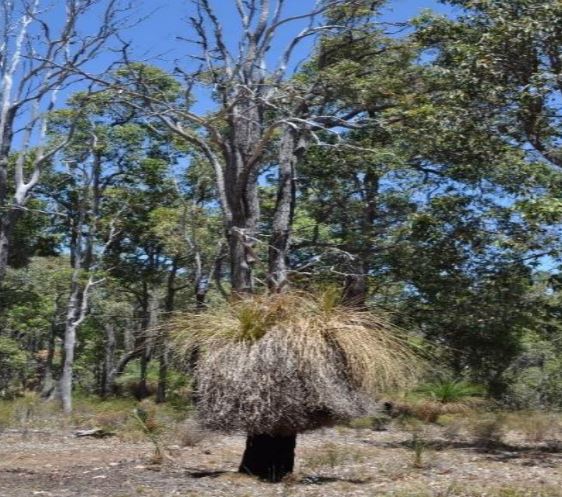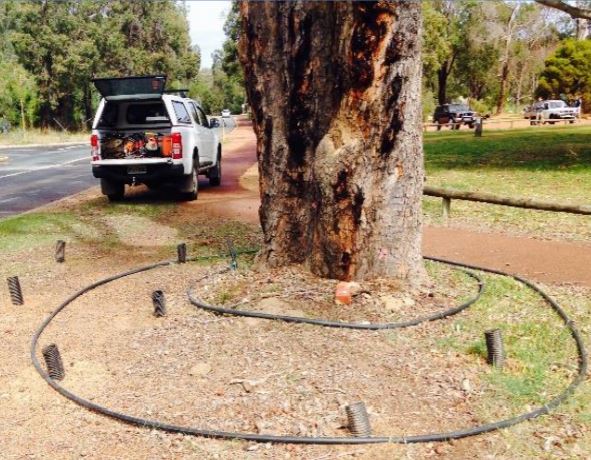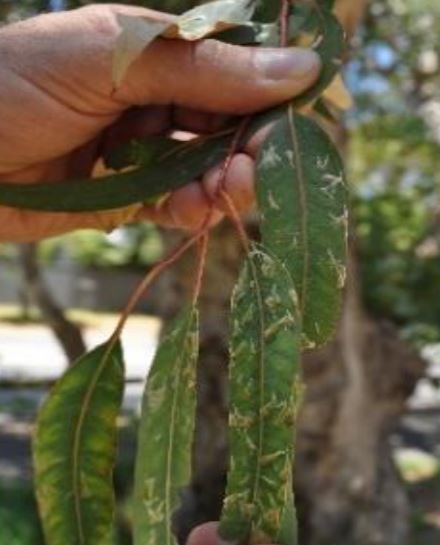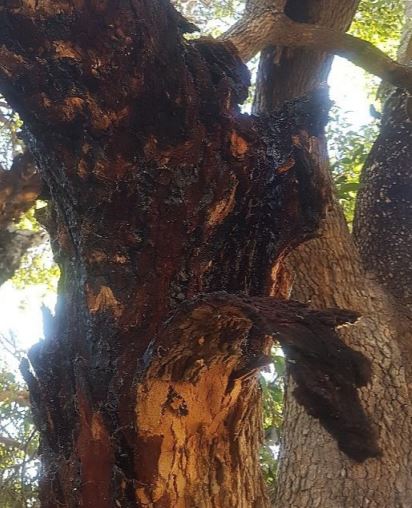Page Title
Dieback in the Shire of Mundaring
 Phytophthora Dieback refers to a plant disease caused by the introduced pathogen Phytophthora cinnamomi. It is a type of water mould that lives in soil and plant tissue that attacks the roots of plants, causing them to rot. As a result, the plants can die very quickly as they are unable to take up water and nutrients. Phytophthora Dieback is found in many areas of the Shire including road verges, bush reserves and your own gardens.
Phytophthora Dieback refers to a plant disease caused by the introduced pathogen Phytophthora cinnamomi. It is a type of water mould that lives in soil and plant tissue that attacks the roots of plants, causing them to rot. As a result, the plants can die very quickly as they are unable to take up water and nutrients. Phytophthora Dieback is found in many areas of the Shire including road verges, bush reserves and your own gardens.
In the past, Phytophthora Dieback has been known as 'dieback' and 'jarrah dieback'. Unfortunately, these names have contributed to confusion about the pathogen. For example, in other parts of Australia, the term 'dieback' is used to describe tree decline caused by such factors as salinity, drought or insect damage. Therefore, to overcome this confusion, the term Phytophthora Dieback is now used.
The disease affects a huge number of introduced and native plant species other than jarrah including banksias, grass trees, roses and fruit trees. Contrary to popular belief, Jarrah trees are not the most susceptible and will usually not be the first to die.
Some plant species are more resistant than others and can survive in dieback infested areas.
How dieback is spread
Phytophthora Dieback is spread via water, soil, and root-to-root contact between plants. Dieback infected soil is easily spread by human activity via muddy shoes, vehicles, earthworks, and equipment.
Once plants and soil are infected, the disease can be treated but not cured. Unfortunately, a report in 2020 confirmed that dieback is already present in parts of our nature reserves and we will need to take care not to spread it further.
Earthworks and construction are high risk activities for spreading dieback. A basic dieback management plan can be used by residents and builders to minimise the risk.
What you can do
Phytophthora Dieback can be initially difficult to detect as the appearance of infected plants can be similar to drought.
If you suspect dieback is present on your property, you can:
- Limit the spread of soil and water to uninfected areas by ensuring all equipment, vehicles and shoes are clean before entering and leaving infected areas and minimising earthworks and soil disturbance (soles of shoes can be disinfected with 70% methylated spirits);
- Protect trees and shrubs from Phytophthora Dieback using phosphite (a biodegradable fungicide that boosts plants natural defences against the pathogen) as an injection into trees, or foliar spray.
To confirm the presence of Phytophthora Dieback, a Dieback consultant may be required to undertake site investigation and collection of soil and plant tissue samples for laboratory testing. For more information view our managing Dieback guide or visit the Dieback Working Group’s website.
Symptoms of stress in trees
Depending on the causes, stressed trees can develop symptoms slowly over years, or very quickly within days or weeks.
Common symptoms to look for include:
- Discolouration or wilting of leaves
- Defoliation (more than normal)
- Heavier than normal seed production
- Dying twigs and branches
- Peeling, splitting or shedding bark
- Presence of fungi on stems and branches
- Presence of insect galls or bore holes in branches and stems
- Abnormal new growth.
Identifying the source of stress
There are a range of environmental factors, pests and diseases that can cause trees to become stressed, lose their leaves, decline or die, including:
- Drought
- Phytophthora Dieback
- Loss or disturbance of understory vegetation
- Soil erosion and compaction
- Waterway pollution
- Salinity
- Fungal disease
- Insects
- Marri canker.
Identifying the source of stress can be difficult as decline may be due to a combination of factors over many years. A qualified arborist or Dieback consultant may be required to confirm which diseases or factors are affecting tree health, and advise on treatment options.
Drought
 Rainfall has measurably decreased in southwest Western Australia over the last 40 years as a result of climate change. Combined with a rise in average temperatures and increased evaporation, this has resulted in reduced water availability.
Rainfall has measurably decreased in southwest Western Australia over the last 40 years as a result of climate change. Combined with a rise in average temperatures and increased evaporation, this has resulted in reduced water availability.
Prolonged periods of low rainfall is termed ‘drought’ and can cause even old, established trees to decline or die due to lack of water.
Symptoms of trees affected by drought
The effects of drought on tree health may not be obvious until years after a drought event. A reduction in vigour, leaf discolouration, leaf drop and excessive epicormic growth are typical symptoms. Drought stressed trees may also become more vulnerable to disease and insect attack.
What you can do
To support drought affected trees on your property, deep watering during dry periods and other measures such as mulching to reduce moisture evaporation form the soil can help.
A qualified arborist should be consulted to determine if deep watering is likely to be beneficial and if so, recommend the most appropriate watering regime and other measures to slow tree decline.
Psyllid Infestation
 Psyllids are insects that are housed in small scales or ‘lerps’ on the leaves of trees such as Flooded Gums (Eucalyptus rudis). They feed on the nutrients stored in leaves, robbing the tree of essential nutrients.
Psyllids are insects that are housed in small scales or ‘lerps’ on the leaves of trees such as Flooded Gums (Eucalyptus rudis). They feed on the nutrients stored in leaves, robbing the tree of essential nutrients.
Symptoms of trees effected by Psyllid
A tree with Psyllids may experience severe leaf discolouration and defoliation.
What you can do
Psyllids are naturally occurring in WA and most trees will recover after insects hatch and fly away.
If a tree is already stressed, it may be unable to cope with an infestation. An insecticide can be used for Psyllid treatment but should be a last resort as it will also kill other beneficial insects, such as bees and predatory insects that eat Psyllids.
Improving soil health around affected trees by mulching, watering, fertilising and planting native understorey can help improve tree health and resistance to insect attack.
Marri Canker
 Marri Canker is a fungal disease affecting marri trees or red gums (Corymbia calophylla), caused by the pathogen Quambalaria coyrecup. It also affects other species such as the red flowering gum (Corymbia ficifolia).
Marri Canker is a fungal disease affecting marri trees or red gums (Corymbia calophylla), caused by the pathogen Quambalaria coyrecup. It also affects other species such as the red flowering gum (Corymbia ficifolia).
Symptoms of trees effected by Marri Canker
The disease causes ‘cankers’ - areas of bark and the tissue beneath to decay. Signs of canker include peeling and splitting bark, lesions on trunks, branches or twigs, and large amounts kino (gum) production which stain the limb or trunk a dark red colour. Once symptoms of canker are visible, trees are unlikely to recover.
What you can do
There are currently no control or management options for marri canker, although trials using fungicides and nutrients are underway.
Improving soil health around affected trees by mulching, watering, fertilising and planting native understorey can help improve tree health and resistance to canker.
Growth of new tree seedlings can be encouraged by fencing off remnant stands of trees and planting understorey species to support a healthier ecosystem.
For more information refer to Murdoch University’s Identifying Marri Canker publication.
Ways to improve tree health
If you are concerned about the health of trees on your property, strategies that can help improve tree health and vigour include:
- Removing weeds
- Re-establishing the understorey with native shrubs to improve soil health and attract insects and birds that predate on Psyllids
- Provide water to drought stressed trees in summer
- Pruning
- Improving soil health.
Improving soil health
Adding a good quality mulch or compost can help to reduce soil moisture loss and increase beneficial soil biota that help trees access nutrients. Addressing soil compaction can help to increase oxygen in the soil and improve water penetration. Removing livestock and avoiding parking vehicles beneath trees is essential to reduce soil compaction.
Pruning
Proper pruning is an essential part of tree care and should be undertaken to remove dead, damaged or diseased branches. This should be done by a qualified arborist, who is trained to selectively eliminate problem branches, correct structural problems and control the shape of a tree.
More information and contact
If the trees are on private property, you can contact a qualified arborist or request help from the Shire’s Environmental Officers to identify potential causes of tree decline. In some cases, they will be able to provide advice based on a photo, or they may need to arrange to visit the site.
If you are seeing decline in street trees on local verges or within reserves, please contact the Shire’s Operations Service on 9290 6716 or email shire@mundaring.wa.gov.au.
For suspected Phytophthora dieback, it is recommended that the initial diagnosis and treatment is undertaken by a dieback specialist.